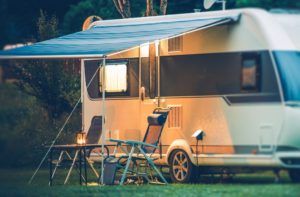Discover How To Use The Power of Authority Marketing To Make You Money While You Adventure!
No Experience, Existing Product Or Technical Skills Are Required
DO YOU BELIEVE ADVENTURES ARE WORTH CHASING?
We're an affiliate.
We hope you love the products/services we recommend on Just Van Life! So you know, there is the possibility we will collect a commission should you make a purchase via any of our links. This will in no way affect the purchase price. Thank you for your support, we really appreciate it!
 If you love to take your camper or RV on road trips, then you know how important it is to have all of the essential equipment to make your camping trip into a great one.
If you love to take your camper or RV on road trips, then you know how important it is to have all of the essential equipment to make your camping trip into a great one.
For the best experiences, you will want to ensure that your camper is kitted up, ready to go, and able to create comfortable space for you, your family or your friends to enjoy.
With a camper awning, you can relax and chill out under the canopy of your awning on all of your trips.
What is a camper awning?
If you have a camper, then you may be thinking about investing in a camper awning. These will fit onto the side of your motorhome, RV or camper, and can be manually or automatically wound out to create a canopy.
These types of awnings are typically mounted to the side of the campervan or from the roof, and will work as a perfect, secluded and closed over area to sit, relax or have dinner under when you are on your travels.
For example, you would install an awning onto your campervan, car, or recreational vehicle to create a shaded, covered over area for you and your family to enjoy during your camping trips.
Many RV’s and campers come with the awning fittings attached, and you can simply purchase the fabric for them. For instance, you can buy RV vinyl awning replacements, or even smaller awnings for SUV’s and other vehicles:
How to install a camper awning
If you want to install a camper awning for your next trip, then you are in the right place. We have created a step by step guide of how to install a camper awning, so that you know exactly what you are doing, when setting up your camper for the evening.
The first step is to purchase a suitable awning kit for your camper. Most kits will include the fabric, the steel mounting brackets and poles to help protect your camper against the wind and the elements.
Once you have your camper awning kit, then you can start thinking about where you are going to put it. Most awnings attach to the side of the camper, or will be attached to the roof, but it is entirely up to you. We recommend that you place the awning on the side of the camper, near the door, that way you can step outside and enjoy the shade under the awning, without having to walk around the camper.
The next step is to take a marker pen, and mark the spot where the ends of your camper awning will be. You can do this with a tape measure, to measure where the best place for your awning would be. Keep in mind that the walls of your camper will need to be at least one inch thick, so that it will definitely be structurally sound enough to hold the whole weight of the awning.
You will be able to find this information in your owner’s manual or by physically measuring the wall through an opening or via a window.
Once you have marked out the ends of where the camper awning will be, you should then draw a straight line between the two marks. You may need help from a friend to do so, and ensure that it is accurate.
You will be able to do this by having one person holding a chalk line, or a straight edge of something, and as they hold it, you can snap the chalk line or alternatively, just trace the line down the straight edge of the object.
The majority of camper awnings will come equipped with mounting brackets in order to install them properly. To get your camper awning up and running, you will need to place the two end mounting brackets approximately three inches inside of the end marks that you drew previously.
Then, take your marker again, and use the felt tip to mark a hole on each bracket, which will give you some guidance as to where you will need to drill later on.
With the third bracket, you will then want to place it directly in the middle of the chalk or straight line that you drew earlier. Again, you will need to use the marker pen to create a dot ready for drilling.
You will find it easier to find the exact middle between the two mounting brackets by measuring the distance between them, and then making a mark at the halfway point. Once you have made all of your markings, you can then leave your mounting brackets to one side whilst you get to drilling your holes!
Before you start drilling, you will need to check the manufacturer instructions that came with your camper awning kit, and see which drill bit size is recommended for the mounting brackets, to ensure that your installation goes as smoothly as possible.
Once you have your recommended drill bit size, you will need to drill straight through your holes that you marked with the pen.
The next step once your holes are drilled, is to coat the screws that came with your camper awning kit with a water tight sealant. We recommend using one such as silicone as this will seal the hole around the screws completely, and prevent any water or moisture from going near your camper.
With your holes drilled, and the screws at the ready, you can work with a screwdriver to screw the brackets into the holes and tighten the screws in. Make sure that you use a hand screwdriver and not a drill as this may over torque the screws, which could damage the structure of your awning, and subsequently, your camper.
Once you have screwed the brackets in, you are ready to move onto the next step. This means that you are ready to hang the camper awning over the mounting brackets and install the awning.
First, you will need to slide the attachment hooks on the brackets, so that these go into the awning. By doing this, you are ensuring that the awning and the brackets are completely, 100% secure before moving onto the next step.
Next, you will want to pull out the support legs of the awning, and pull it out until the canopy, or the fabric is positioned properly, and fully extended. Once the awning is completely extended, you will notice if you need to make any torsion adjustments, which can be done with a small knob on the side of the camper awning. By adjusting this, you will be able to see how tightly the awning is stretched when it is fully extended.
For your convenience, you may want to purchase a deflapper. This is a handy device that works to prevent flapping on the canopy, which can happen frequently with high winds or blustery weather.
When the canopy flaps excessively, this can lead to tearing and ripping of the fabric. So, if you want your camper awning to last for many trips to come, you will want to increase the longevity of your awning by purchasing a handy deflapper.
Finally, we recommend that you skew your awning slightly, and have one end slightly higher than the other when it is pitched. This will allow for condensation and rain to flow off to one side, rather than sitting and weighing down the top.
Now that you have installed your camper awning, you can enjoy relaxing in the shade of the canopy on your next camping trip!
Discover How To Use The Power of Authority Marketing To Make You Money While You Adventure!
No Experience, Existing Product Or Technical Skills Are Required
DO YOU BELIEVE ADVENTURES ARE WORTH CHASING?
